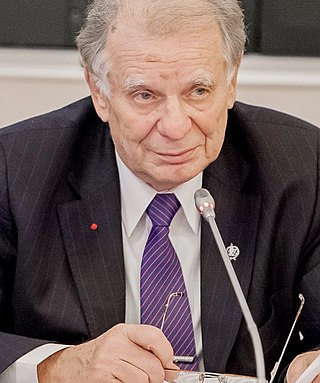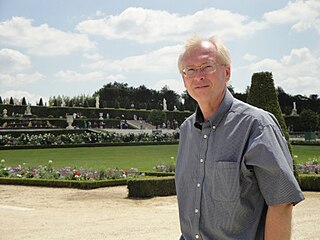Related Research Articles

Zhores Ivanovich Alferov was a Soviet and Russian physicist and academic who contributed significantly to the creation of modern heterostructure physics and electronics. He shared the 2000 Nobel Prize in Physics for the development of the semiconductor heterojunction for optoelectronics. He also became a politician in his later life, serving in the lower house of the Russian parliament, the State Duma, as a member of the Communist Party from 1995.

Abram Fedorovich Ioffe was a prominent Soviet physicist. He received the Stalin Prize (1942), the Lenin Prize (1960) (posthumously), and the Hero of Socialist Labor (1955). Ioffe was an expert in various areas of solid state physics and electromagnetism. He established research laboratories for radioactivity, superconductivity, and nuclear physics, many of which became independent institutes.

Peter the Great St. Petersburg Polytechnic University, abbreviated as SPbPU, is a public technical university located in Saint Petersburg, Russia. The university houses one of the country's most advanced research labs in hydro–aerodynamics. The university's alumni include Nobel Prize winners, such as Pyotr Kapitsa and Zhores Alferov, physicists and atomic weapon designers such as Yulii Khariton, Nikolay Dukhov, Abram Ioffe, Aleksandr Leipunskii, and Yakov Zeldovich, aircraft designers and aerospace engineers, such as Yulii Khariton, Oleg Antonov, Nikolai Polikarpov, and Georgy Beriev, and chess grandmasters, such as David Bronstein. The university offers academic programs at the Bachelor, Master's, and Doctorate degree levels. SPbSPU consists of structural units called Institutes divided into three categories: Engineering Institutes, Physical Institutes, and Economics and Humanities Institutes. In 2022, the university was ranked #301 in the world in the Times Higher Education (THE) World University Rankings, #393 in QS World University Rankings, #679 in Best Global Universities Rankings by U.S. News & World Report, and #1,005 by Center for World University Rankings.
Chih-Tang "Tom" Sah is a Chinese-American electronics engineer and condensed matter physicist. He is best known for inventing CMOS logic with Frank Wanlass at Fairchild Semiconductor in 1963. CMOS is used in nearly all modern very large-scale integration (VLSI) semiconductor devices.

Asad Ali Abidi is a Pakistani-American electrical engineer. He serves as a tenured professor at University of California, Los Angeles, and is the inaugural holder of the Abdus Salam Chair at the Lahore University of Management Sciences (LUMS). He is best known for pioneering RF CMOS technology during the late 1980s to early 1990s. As of 2008, the radio transceivers in all wireless networking devices and modern mobile phones are mass-produced as RF CMOS devices.
Daniel Berg is a educator, scientist and was the fifteenth president of Rensselaer Polytechnic Institute.
Mau-Chung Frank Chang is Distinguished Professor and the Chairman of Electrical Engineering department at the University of California, Los Angeles, where he conducts research and teaching on RF CMOS design, high speed integrated circuit design, data converter, and mixed-signal circuit designs. He is the Director of the UCLA High Speed Electronics Laboratory.
Bantval Jayant Baliga is an Indian electrical engineer best known for his work in power semiconductor devices, and particularly the invention of the insulated gate bipolar transistor (IGBT).
Ernst Weber, Austria-born American electrical engineer, was a pioneer in microwave technologies and played an important role in the history of the New York University Tandon School of Engineering, where in 1945 he founded the Microwave Research Institute. Weber was also the first president of the Institute of Electrical and Electronics Engineers (IEEE) and one of the founders of the U.S. National Academy of Engineering (NAE).

Supriyo Datta is an Indian–American researcher and author. A leading figure in the modeling and understanding of nano-scale electronic conduction, he has been called "one of the most original thinkers in the field of nanoscale electronics."

Sorab (Soli) K. Ghandhi was a professor Emeritus at Rensselaer Polytechnic Institute (RPI) known for his pioneering work in electrical engineering and microelectronics education, and in the research and development of Organometallic Vapor Phase Epitaxy (OMVPE) for compound semiconductors. He was the recipient of the IEEE Education Award "For pioneering contributions to semiconductor and microelectronics education" in 2010.
Mark S. Lundstrom is an American electrical engineering researcher, educator, and author. He is known for contributions to the theory, modeling, and understanding of semiconductor devices, especially nanoscale transistors, and as the creator of the nanoHUB, a major online resource for nanotechnology. Lundstrom is Don and Carol Scifres Distinguished Professor of Electrical and Computer Engineering and in 2020 served as Acting Dean of the College of Engineering at Purdue University, in West Lafayette, Indiana.
Anthony George Constantinides FREng FIET is a professor of signal processing and the founder of the Communications and Signal Processing Group of the Department of Electrical and Electronic Engineering in Imperial College London. He has been actively involved with research in various aspects of digital filter design, digital signal processing, and communications for more than 40 years. Professor Constantinides' research spans a wide range of digital signal processing and communications, both from the theoretical as well as the practical points of view. His recent work has been directed toward the demanding problems arising in Financial signal processing and he now leads the Financial Signal Processing Lab in the EEE department of Imperial College London.

Daniel M. Fleetwood is an American scientist, inventor, engineer and innovator. He is credited as being one of the first to identify the origins of flicker noise in semiconductor devices and its usefulness in understanding the effects of ionizing radiation on microelectronic devices and materials.
Sudip K. Mazumder is a UIC Distinguished Professor and is the Director of Laboratory for Energy and Switching-Electronic Systems (LESES) in the Department of Electrical and Computer Engineering at the University of Illinois Chicago (UIC), which he joined in 2001. He has over 30 years of professional experience and has held R&D and design positions in leading industrial organizations, and has served as technical consultant for several industries. He also serves as the President of NextWatt LLC since 2008.

Igor Vsevolodovich Grekhov is a Soviet and Russian physicist and electrical engineer, full member of the Russian Academy of Sciences. He is known as one of the founders of the power semiconductor device industry in the Soviet Union. His contributions to the field of pulsed power devices and converter technique were recognized by the awarding of the Lenin Prize, the two State Prizes and several State orders of Russia. He headed the laboratory at the Ioffe Physical Technical Institute in St. Petersburg over several decades.
James F. Gibbons is an American electrical engineer and academic administrator. He is credited with starting the semiconductor device fabrication laboratory at Stanford University that enabled the semiconductor industry and created Silicon Valley.

John E. Kelly III is an American executive at IBM. He has been described as the "father" of Watson, a computer system most known for competing against humans on Jeopardy! He joined IBM in 1980 and has served as the director of IBM Research.

Sandip Tiwari is an Indian-born electrical engineer and applied physicist. He is the Charles N. Mellowes Professor of Engineering at Cornell University. His previous roles were Director of National Nanotechnology Users Network, Director of the National Nanotechnology Infrastructure Network, and research scientist at IBM T. J. Watson Research Center. He is best known for his pioneer research in the fields of SiGe transistor and nanocrystal memory.
References
- ↑ Marquis Who's Who. 2010.
- 1 2 "CIE Faculty Page" . Retrieved 7 September 2010.
- ↑ "IEEE Donald G. Fink Prize Paper Award Recipients" (PDF). IEEE. Retrieved January 2, 2011.
- ↑ "IEEE Leon K. Kirchmayer Graduate Teaching Award Recipients" (PDF). IEEE . Retrieved January 10, 2011.